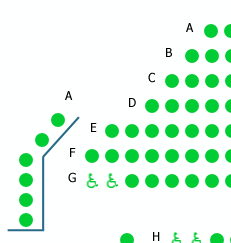
Tags are checkboxes against customer records which allow you to record pieces of information about each customer. These can be information you store against a customer, such as categories (e.g. press, agent, VIP etc.) or auto-tags which apply automatically when a customer has met certain criteria (such as having booked a certain number of times in a given year). Each customer can have as many tags as necessary, and you can use them for any purpose you want, as they’re entirely customizable. If you can think of some information you’d like to capture or record, you can do that with a tag.
Once you’ve set your tags up though, what should you be doing with that information? And what sort of things can you use tags for other than the obvious options? We’ve come up with five cool ways to use tags to allow you to help or reward your customers.
1. Lock eligibility for access schemes
If you run an access scheme for customers who have additional access requirements, you probably want to hold some tickets off so that they’re always available for these customers. Traditionally these tickets have only been available via venue box offices and not online, but isn’t that a bit unfair? How about letting customers with access requirements log in online to purchase their tickets without having to get in touch with the box office? If you tag all of these customers, you can use that tag to power lock eligibility online, and then lock off the seats that you want to make available for them.
2. ‘Ways to book’ emails for customers who have problems booking
Have you ever had a customer who’s struggled to book online, and made their way to the box office exasperated and anxious to get their tickets? These are exactly the customers who need to be reassured that next time they book there won’t be any problems.
Try adding a tag which can power either an integrated email or an email program, including details on all the different ways to book tickets along with contact details for the box office. You can set up a scheduled Customer List looking for customers with that tag who haven’t yet received this email, or use the tag as an enrolment rule in a program.
3. Priority booking for customers who missed out last time
It can be really frustrating to miss out on hot tickets because of a problem booking online. A customer might not have been able to get tickets this time, but maybe you could give them a helping hand for the next big show? You could add a tag to these customers’ records which you use to power a priority booking period for the next show - this way anyone who had real problems previously can get the opportunity to book tickets a day or two in advance before seats disappear on general sale.
4. Loyalty offers for members who book regularly
Members are a real asset to your venue, but how do you reward those members who go above and beyond, and consistently come along to all of your events? How about rewarding them further once they have visited a certain number of times? Set up an auto tag to apply to any customers who a) are a member and b) have visited 10 times this year, and use that as the eligibility for a loyalty offer which gives a different discount, with the aim of maximizing revenue. Maybe money off merchandise, or an offer which encourages attending in bigger groups. That way you don’t have to do anything yourself - as soon as a customer reaches that point, the new offer will automatically kick in.
5. Drive times (postcodes)
When analyzing your audiences, it can be useful to see how far people are prepared to drive to come and visit your venue. Once you have that information you can use it to help make informed decisions with your marketing campaigns - the information is all there in the system already, but by using tags you can pull it out in simple, meaningful ways.
This one’s a little more complicated to set up, but once you’ve set it up the work’s pretty much all done. You need to gather together the postcode districts near your venue, and work out roughly how long it takes to get from each one to you - split these up into bunches, maybe <15 minutes, <30 minutes, <60 minutes and so on. Set up an auto tag for each bunch, looking at customers whose postcode district falls into each one, then the Spektrix support team can build a report looking at number of customers, and number and value of tickets, that have been purchased for each bunch.
These are just a few of the clever ways we’ve thought of to use tags, but there are endless different options. If you need a hand setting any of these up please don’t hesitate to get in touch with the Spektrix Support team, and if you’ve got any great ideas of your own why not share them below?
Learn more about segmentation in our practical, 30-minute Spotlight Session recordings

